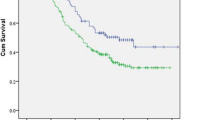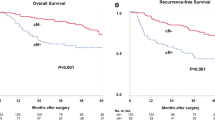Abstract
Background
The clinical significance of pre-therapeutic nodal size in patients with esophageal squamous cell carcinoma (ESCC) is not clear. We investigated whether nodal size was correlated with survival in patients undergoing neo-adjuvant treatment followed by esophagectomy for ESCC.
Methods
In 2009–2013, 222 patients who underwent neo-adjuvant treatment followed by esophagectomy for ESCC were enrolled in this retrospective study. Nodal size was measured along the short axis of the largest node using pre-therapeutic CT images. Patients were then stratified based on this short axis, and nodal size was correlated with clinicopathological factors and survival.
Results
Patients with larger nodes were likely to have deeper cT, higher cN status, and poorer survival. Among the clinical factors cT, cN, cM, and nodal size, only cT and nodal size were independent prognostic factors in multivariate analysis [hazard ratio (HR) 2.0, 95 % confidence interval (CI) 1.1–3.5, p = 0.025 and HR 1.5, 95 % CI 1–2.3, p = 0.036, respectively]. In addition, nodal size was significantly associated with hematological recurrence (p = 0.007), but not lymphatic relapse (p = 0.272).
Conclusions
The short axis of the largest node before neo-adjuvant treatment in patients with ESCC is a prognostic factor.


Similar content being viewed by others
References
Soerjomataram I, Lortet-Tieulent J, Parkin DM et al (2012) Global burden of cancer in 2008: a systematic analysis of disability-adjusted life-years in 12 world regions. Lancet 380:1840–1850
Ferlay J, Soerjomataram I, Dikshit R et al (2015) Cancer incidence and mortality worldwide: sources, methods and major patterns in GLOBOCAN 2012 International journal of cancer. J Int Cancer 136:E359–E386
Soji Ozawa YT, Baba Hideo, Matsubara Hisahiro, Muro Kei, Numasaki Hodaka, Oyama Tsuneo, Shinoda Masayuki, Takeuchi Hiroya et al (2010) Comprehensive registry of esophageal cancer in Japan, 2002. Esophagus 7:7–22
van Hagen P, Hulshof MC, van Lanschot JJ et al (2012) Preoperative chemoradiotherapy for esophageal or junctional cancer. N Engl J Med 366:2074–2084
Cunningham D, Allum WH, Stenning SP et al (2006) Perioperative chemotherapy versus surgery alone for resectable gastroesophageal cancer. N Engl J Med 355:11–20
Ychou M, Boige V, Pignon JP et al (2011) Perioperative chemotherapy compared with surgery alone for resectable gastroesophageal adenocarcinoma: an FNCLCC and FFCD multicenter phase III trial. J Clin Oncol 29:1715–1721
Ando N, Kato H, Igaki H et al (2012) A randomized trial comparing postoperative adjuvant chemotherapy with cisplatin and 5-fluorouracil versus preoperative chemotherapy for localized advanced squamous cell carcinoma of the thoracic esophagus (JCOG9907). Ann Surg Oncol 19:68–74
Ichikawa H, Miyata G, Miyazaki S et al (2013) Esophagectomy using a thoracoscopic approach with an open laparotomic or hand-assisted laparoscopic abdominal stage for esophageal cancer: analysis of survival and prognostic factors in 315 patients. Ann Surg 257:873–885
Akutsu Y, Matsubara H (2011) The significance of lymph node status as a prognostic factor for esophageal cancer. Surg Today 41:1190–1195
Lin CS, Chang SC, Wei YH et al (2009) Prognostic variables in thoracic esophageal squamous cell carcinoma. Ann Thorac Surg 87:1056–1065
Udagawa H, Ueno M, Shinohara H et al (2012) The importance of grouping of lymph node stations and rationale of three-field lymphadenectomy for thoracic esophageal cancer. J Surg Oncol 106:742–747
Tachimori Y, Ozawa S, Numasaki H et al (2014) Supraclavicular node metastasis from thoracic esophageal carcinoma: a surgical series from a Japanese multi-institutional nationwide registry of esophageal cancer. J Thorac Cardiovasc Surg 148:1224–1229
Markar SR, Gronnier C, Duhamel A et al (2016) Significance of microscopically incomplete resection margin after esophagectomy for esophageal cancer. Ann Surg 263:712–718
Reid TD, Chan DS, Roberts SA et al (2012) Prognostic significance of circumferential resection margin involvement following esophagectomy for cancer and the predictive role of endoluminal ultrasonography. Br J Cancer 107:1925–1931
Dexter SP, Sue-Ling H, McMahon MJ et al (2001) Circumferential resection margin involvement: an independent predictor of survival following surgery for oesophageal cancer. Gut 48:667–670
Hermanek P (1995) pTNM and residual tumor classifications: problems of assessment and prognostic significance. World J Surg 19:184–190
Tong DK, Law S, Kwong DL et al (2010) Histological regression of squamous esophageal carcinoma assessed by percentage of residual viable cells after neoadjuvant chemoradiation is an important prognostic factor. Ann Surg Oncol 17:2184–2192
Rice TW, Rusch VW, Ishwaran H et al (2010) Cancer of the esophagus and esophagogastric junction: data-driven staging for the seventh edition of the American Joint Committee on Cancer/International Union Against Cancer Cancer Staging Manuals. Cancer 116:3763–3773
Moorjani N, Junemann-Ramirez M, Judd O et al (2007) Endoscopic ultrasound in esophageal carcinoma: comparison with multislice computed tomography and importance in the clinical decision making process. Minerva Chir 62:217–223
Noda N, Sasako M, Yamaguchi N et al (1998) Ignoring small lymph nodes can be a major cause of staging error in gastric cancer. Br J Surg 85:831–834
Monig SP, Schroder W, Baldus SE et al (2002) Preoperative lymph-node staging in gastrointestinal cancer—correlation between size and tumor stage. Onkologie 25:342–344
Dhar DK, Tachibana M, Kinukawa N et al (2002) The prognostic significance of lymph node size in patients with squamous esophageal cancer. Ann Surg Oncol 9:1010–1016
Bollschweiler E, Besch S, Drebber U et al (2010) Influence of neoadjuvant chemoradiation on the number and size of analyzed lymph nodes in esophageal cancer. Ann Surg Oncol 17:3187–3194
Sobin L, Gospodarowicz M, Wittekind C (2009) TNM classification of malignant tumours, 7th edn. Wiley, New York
Mizowaki T, Nishimura Y, Shimada Y et al (1996) Optimal size criteria of malignant lymph nodes in the treatment planning of radiotherapy for esophageal cancer: evaluation by computed tomography and magnetic resonance imaging. Int J Radiat Oncol Biol Phys 36:1091–1098
Schwartz LH, Bogaerts J, Ford R et al (2009) Evaluation of lymph nodes with RECIST 1.1. Eur J Cancer 45:261–267
Wang ZW, Zhang W, Dong W et al (2014) Pathological analysis of extracapsular extension of metastatic lymph node and its potential impact on nodal clinical target volume in the radiotherapy of esophageal squamous cell carcinoma. Neoplasma 61:324–330
Lagarde SM, ten Kate FJ, de Boer DJ et al (2006) Extracapsular lymph node involvement in node-positive patients with adenocarcinoma of the distal esophagus or gastroesophageal junction. Am J Surg Pathol 30:171–176
Tanabe T, Kanda T, Kosugi S et al (2007) Extranodal spreading of esophageal squamous cell carcinoma: clinicopathological characteristics and prognostic impact. World J Surg 31:2192–2198
Metzger R, Bollschweiler E, Drebber U et al (2010) Neoadjuvant chemoradiotherapy for esophageal cancer: impact on extracapsular lymph node involvement. World J Gastroenterol 16:1986–1992
Metzger R, Drebber U, Baldus SE et al (2009) Extracapsular lymph node involvement differs between squamous cell and adenocarcinoma of the esophagus. Ann Surg Oncol 16:447–453
Tokunaga M, Sugisawa N, Tanizawa Y et al (2013) The impact of preoperative lymph node size on long-term outcome following curative gastrectomy for gastric cancer. Ann Surg Oncol 20:1598–1603
Acknowledgments
We appreciate the kind support of Dr. Takazawa Y. as a pathologist.
Author information
Authors and Affiliations
Corresponding author
Ethics declarations
Conflict of interest
The authors declared no conflict of interest.
Rights and permissions
About this article
Cite this article
Mine, S., Watanabe, M., Imamura, Y. et al. Clinical Significance of the Pre-therapeutic Nodal Size in Patients Undergoing Neo-Adjuvant Treatment Followed by Esophagectomy for Esophageal Squamous Cell Carcinoma. World J Surg 41, 184–190 (2017). https://doi.org/10.1007/s00268-016-3675-y
Published:
Issue Date:
DOI: https://doi.org/10.1007/s00268-016-3675-y




